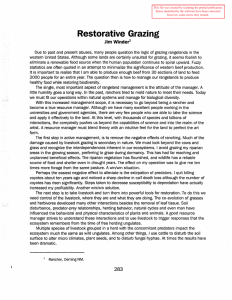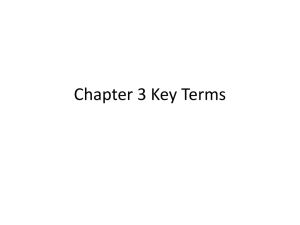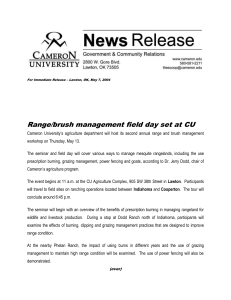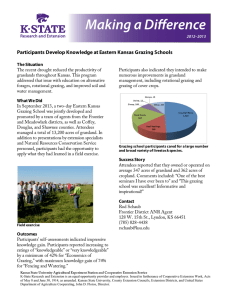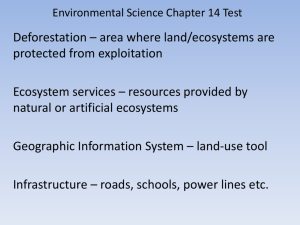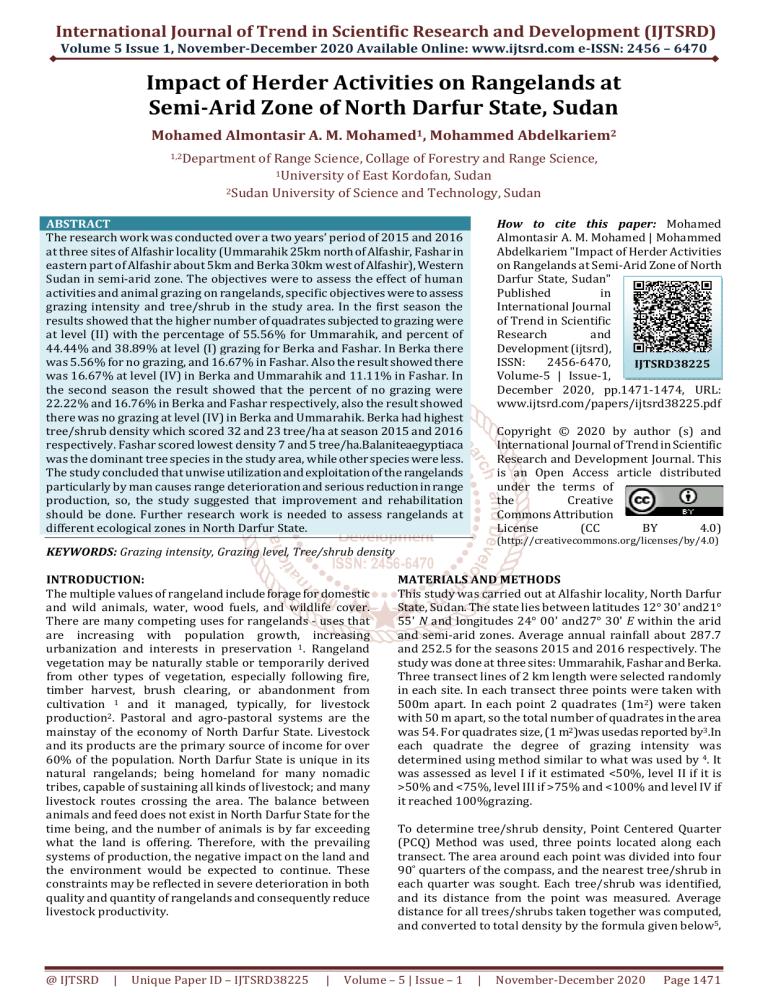
International Journal of Trend in Scientific Research and Development (IJTSRD)
Volume 5 Issue 1, November-December 2020 Available Online: www.ijtsrd.com e-ISSN: 2456 – 6470
Impact of Herder Activities on Rangelands at
Semi-Arid Zone of North Darfur State, Sudan
Mohamed Almontasir A. M. Mohamed1, Mohammed Abdelkariem2
1,2Department
of Range Science, Collage of Forestry and Range Science,
1University of East Kordofan, Sudan
2Sudan University of Science and Technology, Sudan
How to cite this paper: Mohamed
Almontasir A. M. Mohamed | Mohammed
Abdelkariem "Impact of Herder Activities
on Rangelands at Semi-Arid Zone of North
Darfur State, Sudan"
Published
in
International Journal
of Trend in Scientific
Research
and
Development (ijtsrd),
ISSN:
2456-6470,
IJTSRD38225
Volume-5 | Issue-1,
December 2020, pp.1471-1474, URL:
www.ijtsrd.com/papers/ijtsrd38225.pdf
ABSTRACT
The research work was conducted over a two years’ period of 2015 and 2016
at three sites of Alfashir locality (Ummarahik 25km north of Alfashir, Fashar in
eastern part of Alfashir about 5km and Berka 30km west of Alfashir), Western
Sudan in semi-arid zone. The objectives were to assess the effect of human
activities and animal grazing on rangelands, specific objectives were to assess
grazing intensity and tree/shrub in the study area. In the first season the
results showed that the higher number of quadrates subjected to grazing were
at level (II) with the percentage of 55.56% for Ummarahik, and percent of
44.44% and 38.89% at level (I) grazing for Berka and Fashar. In Berka there
was 5.56% for no grazing, and 16.67% in Fashar. Also the result showed there
was 16.67% at level (IV) in Berka and Ummarahik and 11.11% in Fashar. In
the second season the result showed that the percent of no grazing were
22.22% and 16.76% in Berka and Fashar respectively, also the result showed
there was no grazing at level (IV) in Berka and Ummarahik. Berka had highest
tree/shrub density which scored 32 and 23 tree/ha at season 2015 and 2016
respectively. Fashar scored lowest density 7 and 5 tree/ha.Balaniteaegyptiaca
was the dominant tree species in the study area, while other species were less.
The study concluded that unwise utilization and exploitation of the rangelands
particularly by man causes range deterioration and serious reduction in range
production, so, the study suggested that improvement and rehabilitation
should be done. Further research work is needed to assess rangelands at
different ecological zones in North Darfur State.
Copyright © 2020 by author (s) and
International Journal of Trend in Scientific
Research and Development Journal. This
is an Open Access article distributed
under the terms of
the
Creative
Commons Attribution
License
(CC
BY
4.0)
(http://creativecommons.org/licenses/by/4.0)
KEYWORDS: Grazing intensity, Grazing level, Tree/shrub density
INTRODUCTION:
The multiple values of rangeland include forage for domestic
and wild animals, water, wood fuels, and wildlife cover.
There are many competing uses for rangelands - uses that
are increasing with population growth, increasing
urbanization and interests in preservation 1. Rangeland
vegetation may be naturally stable or temporarily derived
from other types of vegetation, especially following fire,
timber harvest, brush clearing, or abandonment from
cultivation 1 and it managed, typically, for livestock
production2. Pastoral and agro-pastoral systems are the
mainstay of the economy of North Darfur State. Livestock
and its products are the primary source of income for over
60% of the population. North Darfur State is unique in its
natural rangelands; being homeland for many nomadic
tribes, capable of sustaining all kinds of livestock; and many
livestock routes crossing the area. The balance between
animals and feed does not exist in North Darfur State for the
time being, and the number of animals is by far exceeding
what the land is offering. Therefore, with the prevailing
systems of production, the negative impact on the land and
the environment would be expected to continue. These
constraints may be reflected in severe deterioration in both
quality and quantity of rangelands and consequently reduce
livestock productivity.
@ IJTSRD
|
Unique Paper ID – IJTSRD38225
|
MATERIALS AND METHODS
This study was carried out at Alfashir locality, North Darfur
State, Sudan. The state lies between latitudes 12° 30' and21°
55' N and longitudes 24° 00' and27° 30' E within the arid
and semi-arid zones. Average annual rainfall about 287.7
and 252.5 for the seasons 2015 and 2016 respectively. The
study was done at three sites: Ummarahik, Fashar and Berka.
Three transect lines of 2 km length were selected randomly
in each site. In each transect three points were taken with
500m apart. In each point 2 quadrates (1m2) were taken
with 50 m apart, so the total number of quadrates in the area
was 54. For quadrates size, (1 m2)was usedas reported by3.In
each quadrate the degree of grazing intensity was
determined using method similar to what was used by 4. It
was assessed as level I if it estimated <50%, level II if it is
>50% and <75%, level III if >75% and <100% and level IV if
it reached 100%grazing.
To determine tree/shrub density, Point Centered Quarter
(PCQ) Method was used, three points located along each
transect. The area around each point was divided into four
90˚ quarters of the compass, and the nearest tree/shrub in
each quarter was sought. Each tree/shrub was identified,
and its distance from the point was measured. Average
distance for all trees/shrubs taken together was computed,
and converted to total density by the formula given below5,
Volume – 5 | Issue – 1
|
November-December 2020
Page 1471
International Journal of Trend in Scientific Research and Development (IJTSRD) @ www.ijtsrd.com eISSN: 2456-6470
Density per hectare = 1000/(D)2
D = average distance, in meter
Information used in the attainment of this study included
both primary and secondary data. Primary data of vegetation
measurements were collected from rangeland through
intensive field surveys, and secondary data was obtained
through various standard published and unpublished
literatures. Measurement tools used include the following:
Measuring tape (100-meter), recording sheet and quadrate
(1mx1m).The statistical package for social science (SPSS, V
16) software program was used to separate between means.
RESULT AND DISCUSSION
Grazing intensity
Table No. 1 show the higher number of quadrates subjected
to grazing was at level (II) grazing for Ummarahik and level
(I) grazing for Berka and Fashar in the season (2015). There
were no grazing quadrates recorded in Berka and Fashar,
this may due to low nutritive value of plants. Also table No. 1
showed there were some quadrates subjected to grazing at
level (IV); this may be attributed to more desirable plants at
the study area, these plants were selected by animals or
removed by human activities, another reason most of the
livestock owners preferred to stay near to the security areas
which is found around Alfashir town, this situation will
result in excessive grazing which can lead to negative impact
on rangelands. 6 stated that livestock grazing and displaced
people activities can be considered as first factors affecting
the study area.
The result in table No. 2 showed there was no grazing at
level (IV) in Berka and Ummarahik; this result may be due to
decrease number of animals or the system of animal grazing
selection in diet. The structure of plant communities is often
changed by grazing since a number of examples where
defoliation by grazing herbivores altered plant height and
canopy cover, and changed species composition to include
structurally different types of plants. Trampling may also
change the structure of plant communities by breaking and
beating down vegetation. This agreed with 7. The forces and
influences discussed above make grazing a valuable
vegetation management tool, while the misuse of domestic
livestock grazing can increase populations of invasive plants.
Proper grazing management can promote desirable
vegetation and reduce invasive plant populations.
Table No. 1: “Grazing levels at different sites of the study in season 2015”
Number of quadrates
No grazing
Level I
Level II
Level III
Level IV
Berka
1
5.56%
7
38.89%
2
11.11%
5
27.77%
3
16.67%
Fashshar
3
16.67%
8
44.44%
4
22.22%
1
5.56%
2
11.11%
Ummarahik
0
0%
5
27.77%
10
55.56%
0
0%
3
16.67%
Level I (<50% grazed), Level II (>50 %< 75% grazed), Level III (>75 %< 100 grazed), Level IV (100% grazed).
Table No. 2: “Grazing levels at different sites of the study in season 2016”
Number of quadrates
No grazing
Level I
Level II
Level III
Level IV
Berka
4
22.22%
7
38.89%
5
27.78%
2
11.11%
0
0%
Fashshar
3
16.67%
4
22.22%
8
44.44%
1
5.56%
2
11.11%
Ummarahik
0
0%
5
27.77%
10
55.56%
3
16.67%
0
0%
Level I (<50% grazed), Level II (>50 %< 75% grazed), Level III (>75 %< 100 grazed), Level IV (100% grazed).
Tree and shrub density
Density is a measure of the number of trees and shrubs in a particular stand, Table No. 3 showed the average density of trees
and shrubs in the study area. Berka had highest tree/shrub density; this may be due to the long distance of this area from IDPs
who is settled at Alfashir town, this agreed with 8. Fashar scored lowest density, this may attribute to the displacement
activities; 6 stated that the range and farms around Alfashir town is less in trees or low, and that due to influence of
displacement activities. Tables No. (4 and 5) indicate that Balaniteaegyptiaca was the dominant tree species in the study area,
while other species were less. This was because some of these tree species are preferred by animals in the study area which
produces leaves during the dry season and was subjected to intensive browsing. Some species was influenced by intensive
cutting for building purposes, shaking off from some trees for animals and fire wood. Human activities involving clearing or
destruction of the area of natural vegetation also have the potential to influence the distribution of tree cover. 9 mentioned the
human activities and the natural variability of rainfall and climate change as the main causes of degradation.The removal of
economically important trees and shrubs by people, usually for wood fuel and construction of houses is regarded as the first
type of vegetation degradation and as the main factors responsible for the decrease and /or the disappearance of woody10.
Heavy browsing can also affect woody species density;it affects populations of trees and shrubs negatively through increased
mortality and decreased reproduction and recruitment 11.
Table No. 3: “Average tree/shrub density in the study area for season 2015 and 2016”
Site
2012 2013
Berka
32
23
Fashar
7
5
Ummarahik
15
10
@ IJTSRD
|
Unique Paper ID – IJTSRD38225
|
Volume – 5 | Issue – 1
|
November-December 2020
Page 1472
International Journal of Trend in Scientific Research and Development (IJTSRD) @ www.ijtsrd.com eISSN: 2456-6470
Table No. 4: “The species density (tree or shrub/ha) in the study area at season 2015”
Species
Berka Fashar Ummarahik
Balanitesaegyptiaca
9
1
6
Acacia tortilis
6
1
3
Calotrophisprocera
7
3
0
Capparis decidua
3
2
0
Bosciasenegalensis
4
0
0
Fedherbiaalbida
3
0
0
Leptadeniapyrotechnica
0
0
3
Zizuphusspina-cristi
0
0
2
Maeruacrassifolia
0
0
1
Total
32
7
15
Table No. 5: “The species density (tree or shrub/ha) in the study area at season 2016”
Species
Berka Fashar Ummarahik
Balanitesaegyptiaca
6
0
4
Acacia tortilis
3
0
1
Calotrophisprocera
7
3
0
Capparis decidua
3
2
0
Bosciasenegalensis
4
0
0
Leptadeniapyrotechnica
0
0
3
Zizuphusspina-cristi
0
0
1
Maeruacrassifolia
0
0
1
Total
23
5
10
Photo No. 1: Effect of human activities on trees in the study area
Photo No. 2: Cutting trees for charcoal as source of income generation
@ IJTSRD
|
Unique Paper ID – IJTSRD38225
|
Volume – 5 | Issue – 1
|
November-December 2020
Page 1473
International Journal of Trend in Scientific Research and Development (IJTSRD) @ www.ijtsrd.com eISSN: 2456-6470
CONCLUSION AND RECOMMENDATION
The rangelands in the study area are subjected to overuse
and depletion of vegetation cover, especially around Alfashir
town, due to increase in human population, animal numbers
and change in environmental conditions. Continuous
removing of trees and overgrazing expose the rangeland to
wind erosion, disappearance of the palatable species given
chance to unpalatable species to establish themselves and
occupy the area. One of the most important techniques in
rangeland management is proper time of grazing. Avoidance
of early grazing when plants are most vulnerable at
germination stage and before seeds setting stage is urgent
because the different species in the different sites have
different responsibility to grazing intensities.
National government should give special attention to the
Forest National Corporation to put into practice its activities
such as nursery establishment, seed distribution, forest
reservation, protection, seedling production and distribution
all over the deteriorated areas especially at the study area in
order to recover the areas which were depleted and eroded
by intensive misuse.
REFERENCES
[1] Heady HF, Child D. Rangeland Ecology and
Management. West view Press, San Francisco,
CA.1994
[2]
Holechek, JL, RD Pieper, CH Herbal. Range
management principles and practices. (5thed).
Pearson Education. Inc. upper Saddle River, New
Jersey2004.
[3]
Lee P, Hanus S. Monitoring of Terrestrial Vascular
Plants and Structure in the Forested Regions of
Alberta: Background, Indicators, and Protocols.
Chapter 13. Alberta Research Council. 83, 1999
@ IJTSRD
|
Unique Paper ID – IJTSRD38225
|
[4]
Saltaz D, H Schmidt, M Brown, A Karneili, D Ward, I
Schmidt. Assessing grazing impacts by remote sensing
in hyper-arid environments. J. Range management 52:
500-507 September 1999
[5]
Cotton G, JT Curtis.
The use of distance
measure in Phyto-Sociological coupling. Ecology
37:451-460.1956
[6]
Rahma AAE. The Impact of Displacement on
Vegetation Cover Around IDP Camps in Alfashir
Locality- North Darfur State- Sudan. M.Sc. Thesis,
Alfashir University, College of Graduate Studies,
Sudan. 2015, Unpublished.
[7]
Huntly N.Herbivores and the dynamics of
communities and ecosystems. Annual Review of
Ecology and Systematics 22:477-503. 1991
[8]
Adam AI. Study on Impact of Darfur Armed Conflict on
Vegetation cover, Case study: Umkaddada Locality
North Darfur State –Sudan, PhD thesis, Sudan
University of Science & Technology, College of
Graduate Studies.2013, Unpublished.
[9]
Mohamed MAM, Elhag FMA, Elnour IA. Rangelands
vegetation under different management systems and
growth stages in north darfur state, sudan (range
attributes), International journal of environment vol3, Issue-3, Jun-Aug 2014, p332-343
[10]
Macharia1 PN,Ekaya, WN. The Impact of Rangeland
Condition and Trend to the Grazing Resources of a
Semi-Arid Environment in Kenya. J. Hum. Ecol., 17(2):
143-147.2005
[11]
Young TP, Augustine DJ. Interspecific Variation in the
Reproductive Response of Acacia Species to
Protection from Large Mammalian Herbivores.
Biotropica 39(4):559–561.2007
Volume – 5 | Issue – 1
|
November-December 2020
Page 1474


